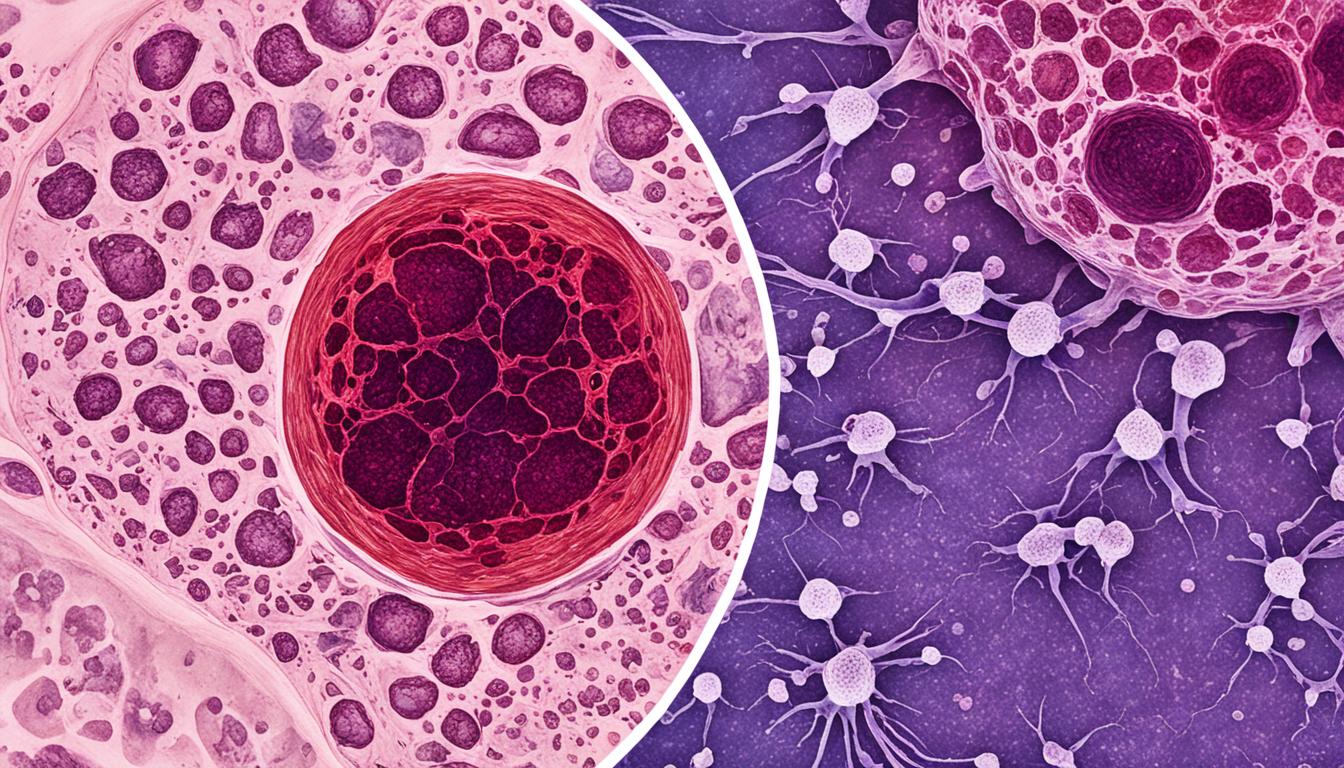Cutaneous B-cell lymphoma targets B cells in the immune system, mostly seen on the skin. It’s known as “skin lymphoma” or “lymphoma skin cancer,” with two primary forms. These are follicle center cell lymphoma and primary cutaneous lymphoma.
The illness shows various symptoms. These can involve pain and swelling where the lymphoma is, and skin problems. Feeling tired, losing weight, and having night sweats are also common. The causes are not fully understood, but certain things like weak immune systems might play a part.
Doctors use many steps to diagnose cutaneous B-cell lymphoma. This includes looking closely at the skin, and taking skin samples to study. Blood work and scans help see how far the lymphoma has spread.
The treatment plan changes with the type and stage of the disease. Options include drugs, radiation, and stem cell therapy. For some, a stem cell transplant is an option.
Many people do well after treatment. But, the outcome depends on the type and stage of the disease, and how well treatment works. Quick action and the right treatment are key for those with symptoms.
Key Takeaways:
- Cutaneous B-cell lymphoma is a form of non-Hodgkin’s lymphoma that affects the skin and B cells in the immune system.
- Symptoms can vary but commonly include pain in the affected area, swollen lymph nodes, and skin-related issues.
- Certain risk factors, such as immunosuppression and autoimmune conditions, may increase the likelihood of developing cutaneous B-cell lymphoma.
- Diagnosing the disease involves physical examination, biopsies, blood tests, and imaging tests.
- Treatments can include chemotherapy, immunotherapy, radiation therapy, stem cell transplant, targeted therapy, and supportive therapy.
Types and Symptoms of Cutaneous B-cell Lymphoma
Cutaneous B-cell lymphoma has several subtypes. The two main ones are follicle center cell lymphoma and primary cutaneous lymphoma.
Follicle center cell lymphoma grows slowly in the skin. It doesn’t usually rush to affect other places over time.
Primary cutaneous lymphoma starts in the skin directly. It’s different because it doesn’t come from somewhere else in the body.
What someone feels with cutaneous B-cell lymphoma can change by subtype. However, people often have pain, swollen lymph nodes, and problems with fatigue. Weight loss and night sweats also point to this condition.
Seeing a doctor if these signs show up is very important. Knowing early and treating quickly can make a big difference.
Diagnosis and Treatment of Cutaneous B-cell Lymphoma
Diagnosing cutaneous B-cell lymphoma needs many steps. It starts with a physical exam. The doctor will look for signs like lumps or red patches.
Then, a skin biopsy is done. This means a small piece of skin is taken. It is checked under a microscope to see if there are cancer cells.
Blood tests can also help. They show how well your immune system works. Imaging tests, like MRIs and CT scans, are crucial. They tell how much lymphoma there is and where it is.
Now, about treating this lymphoma. The plan is made for each person. It depends on the lymphoma’s type and stage. Options include drugs, like chemotherapy and immunotherapy. There’s also radiation, targeted therapy, and supportive care.
In some cases, a stem cell transplant might be used. This is a major step. Healthy stem cells from a matched donor are put into your body. This can sometimes cure the lymphoma.
FAQ
Q: What is cutaneous B-cell lymphoma?
A: Cutaneous B-cell lymphoma is part of non-Hodgkin’s lymphoma, affecting immune system B cells.
Q: What are the symptoms of cutaneous B-cell lymphoma?
A: It can cause various symptoms. These might include pain and swelling in the affected area. Other signs are weight loss, night sweats, and feeling tired. Seeing a doctor for these signs is crucial for proper diagnosis.
Q: What causes cutaneous B-cell lymphoma?
A: The exact causes are unknown. Yet, we know certain factors like immune system suppression raise the risk.
Q: How is cutaneous B-cell lymphoma diagnosed?
A: To diagnose it, a doctor might examine you physically, take a biopsy, and run blood tests. A skin biopsy looks at the skin under a microscope. Blood tests and imaging like MRIs can help see the lymphoma’s reach.
Q: What are the treatment options for cutaneous B-cell lymphoma?
A: Treatments vary by type and stage. They can include chemotherapy, radiation, and more. Stem cell transplants and targeted therapy are also options. Your doctor will suggest what’s best for you.
Q: What is the prognosis for cutaneous B-cell lymphoma?
A: Prognosis varies based on type, stage, and treatment success. Yet, survival rates are often good. Treatment effectiveness and overall health play big roles in recovery.

